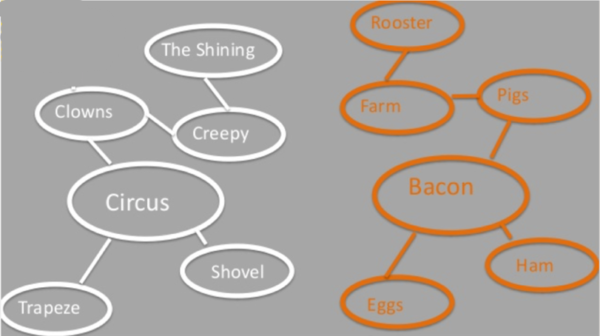
Want to get more creative in your marketing, especially your storytelling? Spend five minutes a day doing something that masters of improv do: Play with words.
That was stand-up comedian Tim Washer’s advice in his talk, How to Use Improv Techniques to Improve Your Storytelling, at Content Marketing World in 2016. He walked us through some examples, which I’ll share in this post.
First, in case you missed my recent article based on this same talk, let me fill you in on who this guy is. In addition to serving as social media manager for Cisco Systems’ Service Provider Marketing group, Tim has worked on Last Week Tonight with John Oliver and Late Night with Conan O’Brien, studied improv under Amy Poehler and written for her on Saturday Night Live’s Weekend Update, and worked as a “corporate humorist” for clients like Google, IBM, FedEx, and Pepsi.
Tim knows corporations and humor.
Read on to learn from an improv master how to become a more creative marketer. (All images come from Tim’s presentation slides.)
Exercise in word play
I saw my first live improv show, when I was 9 or so. My dad took my sister and me to Second City in Chicago. One of the actors asked for the name of an animal. “Aardvark!” I shouted. How on earth would they weave a reference to an aardvark into their skit?
It seemed impossible that this team of energetic people on the stage could create a vignette on the spot using the audience’s suggestions. As they did exactly that, I waited, waited, waited. Finally, at the end of the skit, one of the actors burst into song, ending with the rousing line “up in a tree, with the aardvark and me!”
How had they pulled it off? It was magic.
Decades later, it still seems like magic to me that any group of people can instantly create a story – let alone a funny story – from a bunch of random words. I never considered trying it myself.
Tim says it’s time to go for it. He urges everyone who does creative work (and we all do creative work) to expand our storytelling capacity by spending five minutes a day, either alone or with a group, playing with word juxtaposition. In other words, yoke unrelated ideas together to create something new.
Spend 5 minutes a day playing a word juxtaposition game to boost creativity, says @TimWasher. #CMWorld Click To TweetYou do this by following the Tim-recommended “path of nonsense”:
- Come up with two unrelated terms. (Try a free random-word-generator app, like InspireMe.)
- Write those terms down on a piece of paper. (Don’t do it in your head.)
- Create a word map or web of words for each term. (Brainstorm. Write, write, write. Don’t stop. Keep your pen moving. No wrong answers. It’s just word association. Free associate. Don’t judge yourself or worry about making mistakes. If it’s crazy, it could lead to gold.)
- Choose a word from each side – a combination that strikes you as having play potential – and free associate only those two words.
- Create a narrative that connects the two ideas. (Ask yourself “What if …?” Keep your mind open and playful.)
“This is one of the best ways to come up with new ideas when you’re staring at a blank piece of paper, and you’re trying to come up with something new,” Tim says. “You can get to genius with this.”
If you do this exercise with others, look for people who like to take risks and who have a sense of humor. “Not people who tell jokes but people who laugh. That shows that they’re open to ideas,” Tim says.
Example 1: Playing with “circus” and “bacon”
Here’s how this exercise went for one group Tim worked with.
- They chose “circus” and “bacon.”
- They wrote the words side by side.
- They created a word map, asking themselves, “What do we know about bacon and circuses? What are the ‘rules of bacon, the rules of a circus’?”

- They decided to connect “clowns” and “farms.” They did more brainstorming, asking, “What do we know about clowns and farms? What do we picture when we think of a clown or a farm?” They came up with this list:

- They mashed up the two attribute lists and came up with this scenario: A rooster crows. The sun is coming up. A tractor appears, coming up over a hill. It stops. Someone jumps out – you see the silhouette. You cut to a close shot, and a farmer takes off his hat. A rainbow afro pops up. He turns sideways and walks off in his clown shoes. Then another clown comes out of the tractor, and another, and another.

Now the team has a silly idea that connects with people. Great. Now what does it do with it. Probably nothing. Who knows? “(They) experienced this process of creativity, and it’s helping (them) become more creative,” Tim says. “That’s what this is about.”
Example 2: Playing with “chinchillas” and “marshmallows”
Tim and the attendees at his 2015 CMWorld talk created another example.
- The audience shouted out “chinchillas” and “marshmallows.”
- Suggested word associations for “chinchillas” included fur, squirrel, and traps, and s’mores and campfires for “marshmallows.”
- Someone suggested a connection between the two word groups – marshmallow traps.
Tim took it from there: “Let’s see how we can marry traps and marshmallows. Maybe we’re doing a commercial for s’mores. You could have a trapper who’s out to trap marshmallows. Once you have that absurd idea, you play it straight, dead serious. Nobody’s winking and laughing. We open on a log cabin that is a retail store for trappers. There’s a guy selling traps, and a guy comes in who has just trapped some marshmallows. What’s the backstory? What would he look like? Does he trap just marshmallows? Is he vegan? Maybe that leads you to a psychologist’s office, where he’s talking about why he doesn’t trap deer any more, just marshmallows.”
I’d love to see someone make that commercial. Alas, a producible idea wasn’t the point.
As Tim shares, “This kind of exercise leads you to absurd ideas. It builds your creativity muscles.”
Word-play exercises lead to absurd ideas. It builds your creativity muscles, says @TimWasher. #CMWorld Click To TweetExample 3: Valentine gift from Cisco
How does all this silliness apply to the content you do need to produce? In that same talk, Tim suggests using a similar exercise when brainstorming your real content ideas – but playing with words related to customer pain.
Look at the pain that your customer is experiencing and that you can solve, and play around in that area. Now you’ve created something relevant. Not only have you made something funny that your customer might laugh at, but you’ve demonstrated that you understand what they’re struggling with and demonstrated empathy. Just exaggerate that pain point.
Tim detailed in his 2016 CMWorld talk how his team at Cisco did some brainstorming when they were getting ready to launch a $100,000 router. (“We sell it to the Verizons, AT&Ts, Telestras of the world. You’re not going to get this at Office Depot. But if you want a coupon, let me know. I can get you 25 bucks off,” he offered.)
The team brainstormed and played around with things they knew about the router – the ASR 9000. Here’s a word map that captures the spirit of their brainstorming:

“We got nowhere. We couldn’t find anything interesting. Then we said, wait a minute, when’s the launch date of this product again? It’s February 9. Almost Valentine’s Day,” Tim says. And the idea for this 60-second video was born: A Special Valentine’s Day Gift … from Cisco!
The concept was absurd. Tim says plenty of people asked, “What are you doing?” But none of Cisco’s other videos earned coverage in The New York Times. Whereas most corporate videos get a couple hundred views, the Valentine one had 200,000 views in its first month, according to Tim. (The view count on the video that’s available today doesn’t reflect all the views from the original 2009 posting.) And this video – which includes only still images, an approach that Tim recommends for ease and simplicity – cost less than its typical video.
Why don’t we do more playing around like this? Even if our ideas fail, why not take a few more shots at it? That’s what I think. Take 2% of your budget and give it a shot.
Conclusion
Who knew that the trick to succeeding at work was to play more? Spend a few minutes a day putting unrelated words together and following them down a path of nonsense.
What do you say – ready to dedicate a little time and 2% of your budget to some silliness?
Catch Tim Washer’s act (and learn a lot about content marketing) at this year’s Content Marketing World. Register today for the Sept. 5-8 event. Use code BLOG100 to save $100.
Cover image by Joseph Kalinowski/Content Marketing Institute

